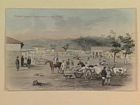The pockmarked landscape, together with the extraordinary human dramas of riches and struggles, inspired many artists on the goldfields. They travelled to the diggings from towns, colonies and across oceans, rendering what they saw on canvases, and a variety of other mediums, as they depicted scenes of comedy, tenderness, hardship or death. Although photography first arrived in Melbourne in the 1840s, it was not widely practised on the goldfields; it was the painters and sketch artists who provided people from Melbourne and afar with pictorial images of the diggings, and a record of the changing landscape and its inhabitants. In sketching the honeycomb landscape of Ballarat’s Golden Point in 1852, William Strutt reminisced: ‘little did I imagine when I sat making this drawing that in a few years this wild spot was to be transformed into a large and beautiful city, and my drawing of the Golden Point the only reliable memorial of the celebrated site.’
Artists, like William Strutt, Samuel Thomas Gill, and Eugene von Guerard, not only depicted the wide vistas of the frontier goldfields, but also portrayed the personal and the commonplace. Scenes of the diggings, from cradles and black troopers to newspaper vendors and hotels, were recorded, as was the devastating impact of gold. Both Strutt and Gill portrayed the death and destruction that was commonplace – not only was the landscape ravished but also people and livestock. In Strutt’s 1851 Martyrs of the road, two dead horses lie in the foreground near other animal remains, while in the background, a line of tired and exhausted people make their slow and arduous way to the diggings. In Gill’s Unlucky digger that never returned, the skeletal remains of a man lie undisturbed under a tree while birds hover overhead. It is as if the man simply laid down to rest and never got up. Arriving in Ballarat in 1853 and remaining there for a year, von Guerard also recorded the melancholic images of fallen chimneys, abandoned holes and the altered landscape.
William Strutt arrived in Victoria from England, in early 1851, with the intention of improving his ailing health. With the discovery of gold, he headed for the fields. In recollecting that period, Strutt wrote: ‘It was in February 1852, when all ordinary work became pretty nearly suspended in town, that I too felt compelled to follow the tide. I don’t think I had much of the gold madness, perhaps not enough to get on.’ With keen observation and an eye for the historic, Strutt created numerous drawings and sketches of the diggings. Upon returning to Melbourne, some months later, he produced a lithograph of Golden Point that was immediately sold in London, and a series of sketches, entitled Diggings life, which appeared in Ham’s publications.
Arriving in Forest Creek in 1852, at the age of 34, S.T. Gill portrayed the diggings as largely peaceful. This contrasts markedly with his portrayal of the surrounding roads where violence and death was omnipresent. With themes of humour and individuality dominating his work, Gill was one of the first Australian artists to portray what many regard as quintessential Australian characteristics. After returning to Melbourne, Gill immediately produced a book of lithographs titled The Victorian gold diggings and diggers as they are, with a subsequent edition published the following year.




